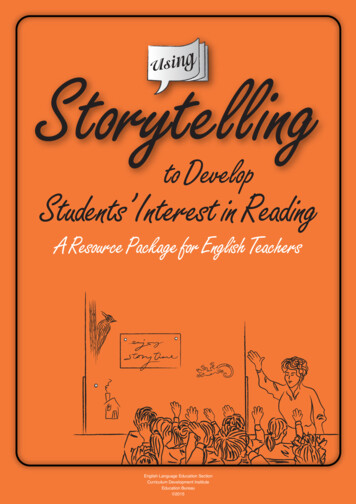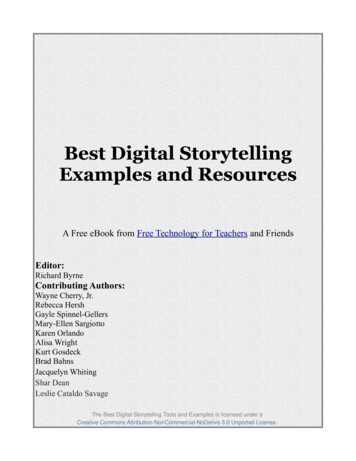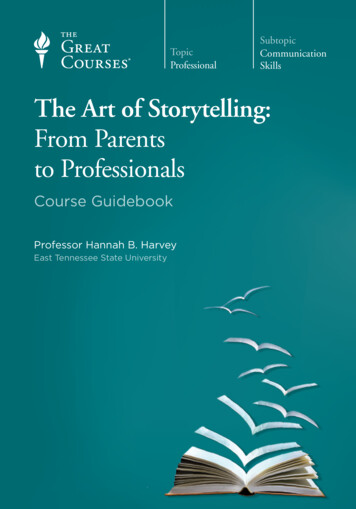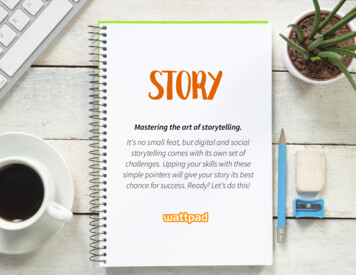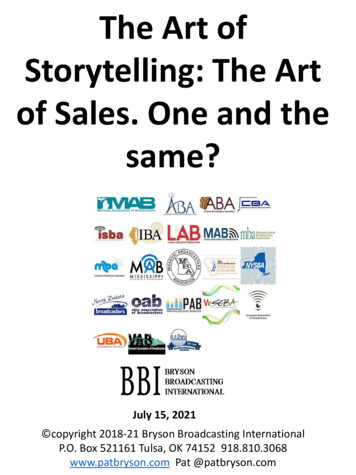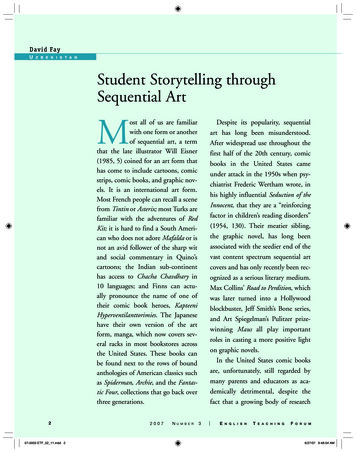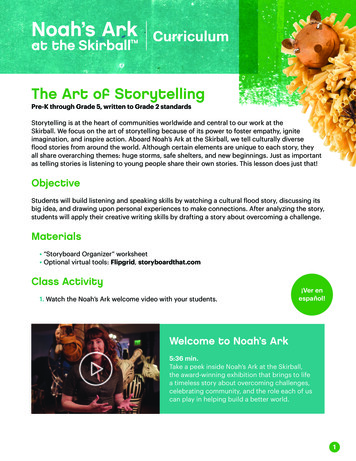
Transcription
CurriculumThe Art of StorytellingPre-K through Grade 5, written to Grade 2 standardsStorytelling is at the heart of communities worldwide and central to our work at theSkirball. We focus on the art of storytelling because of its power to foster empathy, igniteimagination, and inspire action. Aboard Noah’s Ark at the Skirball, we tell culturally diverseflood stories from around the world. Although certain elements are unique to each story, theyall share overarching themes: huge storms, safe shelters, and new beginnings. Just as importantas telling stories is listening to young people share their own stories. This lesson does just that!ObjectiveStudents will build listening and speaking skills by watching a cultural flood story, discussing itsbig idea, and drawing upon personal experiences to make connections. After analyzing the story,students will apply their creative writing skills by drafting a story about overcoming a challenge.Materials “Storyboard Organizer” worksheet Optional virtual tools: Flipgrid, storyboardthat.comClass Activity1. Watch the Noah’s Ark welcome video with your students.¡Ver enespañol!Welcome to Noah’s Ark5:36 min.Take a peek inside Noah’s Ark at the Skirball,the award-winning exhibition that brings to lifea timeless story about overcoming challenges,celebrating community, and the role each of uscan play in helping build a better world.1
2. Have a class discussion about storytelling. Why do we tell stories? What stories do you know and who tells them? Who is included in the stories? Who is missing?3. The two videos shared here are some of the most frequently told stories aboardNoah’s Ark. Choose one of the videos to share with your students. Show it all the waythrough for comprehension.A Lenape Flood StoryA Maasai Flood Story7:33 min.Join Noah’s Ark educator Dillon for a storyadapted from one told by the Lenape, anIndigenous people of the northeasternwoodlands of Canada and the United States.Watch how animals work together to overcomea challenge and learn that even small acts canmake a big difference.5:45 min.Join Noah’s Ark educator Dena as she shares alyrical adaptation of a story told by the Maasai, agroup of people from Kenya and Tanzania in EastAfrica. Take part in a journey to find land alongside a lion, a cheetah, a dove, and a vulture whomakes a surprising discovery.Note: The storyteller has chosen to respectfullypay homage to the East African dialect based onactive research.4. Watch the video again to analyze the story by identifying key details. Like all stories, thesestories have a beginning, middle, and end. In the beginning there is a “storm” or challenge,in the middle there is an “ark” or action, and in the end there is a “rainbow” or moment ofcelebration. Think about the story arc and discuss the questions below.BeginningStorm Challenge What characters stood outto you? What is the setting, or wheredoes the story take place? What was the obstacleor problem?MiddleArk Action What were some moments of acharacter taking action? How did the characters worktogether?EndRainbow Celebration What was the solution thatsolved the problem? How did the characters feelafterward?2
5. Have a class discussion about the story you watched. What do you think the big idea of this story is? Several animals described the skills, strengths, and talents they could use to help findland. What special skills do you use to help others? Talk about a time when you believed in yourself and overcame a challenge.Student Instructions Write your own story using the “Storyboard Organizer” worksheet. As an optional step, youcan use storyboardthat.com to illustrate your story online. Optional: Reflect on what you’ve learned about yourself as a writer and storyteller using the“Self-Reflection” worksheet.Share OutParticipate in a storyteller circle for students to share their stories with one another. Encouragestudents to listen for commonalities and ask questions.Theater Arts ActivityRewatch the flood story and look carefully at the way the storyteller tells the story. What do theydo with their hands, their voice, and their eyes to draw the viewer into the story? Oral storytellingstrategies may include eye contact, breath, audience engagement (such as asking questions),hand gestures, and voice fluctuation. Have students make a list of strategies they would like totry when telling their own stories. Practice with Flipgrid!Cultural ConnectionsLearn more about the cultures reflected in the stories using the resources below:Lenape CultureMaasai CultureNative-land.ca: An interactive map of nativeterritories across the globe. Look for the Lenapeterritories in the northeastern woodlands ofCanada and the United States. Then, find whatNative land you are on. Follow the resources listedon the site to learn about Native people, history,and culture.Maasai Association: A community-basednonprofit dedicated to preserving and celebratingMaasai cultural heritage.Nanticoke and Lenape Confederation LearningCenter and Museum: A space dedicated to sharingthe tribal history and culture of the Delaware Bay.Art & Life in Africa: A freely accessibleeducational resource on African art, culture,life, and history. Learn more about the Maasaipeople here.Stories of the Lenape People: A compilation ofLenape stories, told by Chief Robert Red Hawk Ruth.3
Curriculum ConnectionsCCSS.ELA-LITERACY: RL.2.2, RL.2.3, RL.2.5, W.2.3, SL.2.2, SL.2.4, L.2.1California Arts Standards: 2.TH:Cr1, 2.TH:Pr4, 2.TH:Pr6, 2.TH:Re8, 2.TH:Re9Connect with UsOur educators are here to help! If you would like to talk with us about how best to facilitate thisactivity with your students, please email teacherprograms@skirball.org.
WorksheetStoryteller (your name!):Storyboard OrganizerMy main character is:Other characters in my story are:The setting of my story is:The main obstacle or problem my characters face is:My characters’ strengths are:The actions the characters take to face the challenge are:My main character solved the problem by:In the end, the characters feel:Reflect: What do you want your audience to remember after hearing or reading your story?
WorksheetName:Self-ReflectionWow, you brought a project to life! Reflect on what you learned about yourself.Project title:I am proud of:My greatest challenge was:I learned:My favorite part was:
The Art of Storytelling Pre-K through Grade 5, written to Grade 2 standards Storytelling is at the heart of communities worldwide and central to our work at the Skirball. We focus on the art of storytelling because of its power to foster empathy, ignite imagination, and inspire action. Aboa
